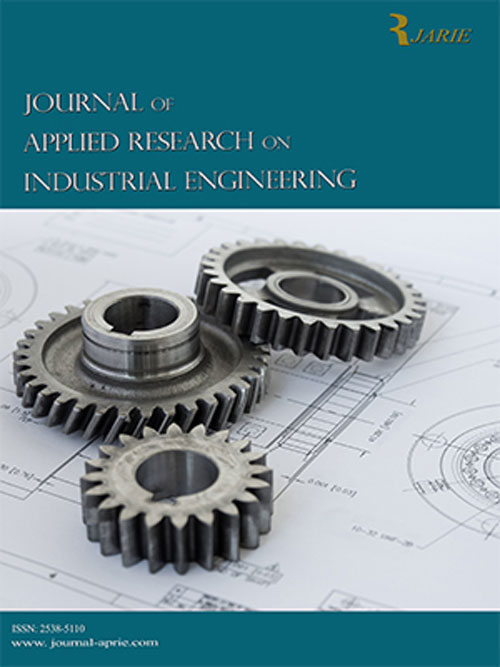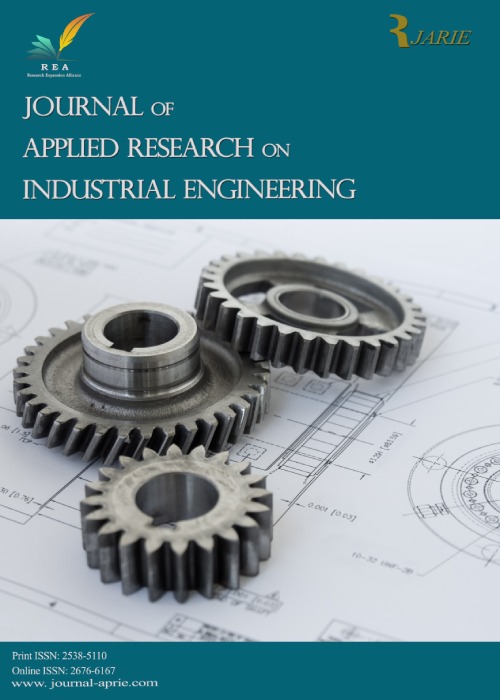فهرست مطالب

Journal of Applied Research on Industrial Engineering
Volume:6 Issue: 2, Spring 2019
- تاریخ انتشار: 1398/02/17
- تعداد عناوین: 7
-
Pages 87-96Enhancing the process capability is a must in quality improvement of process manufacturing in the industry. Usually, Statistical Process Control (SPC) is applied in measure the activity of quality improvement. In this case, the statistical process control used to measure the process capability of molding machine regarding of force result of inner contact rubber button in plastic industry. The forces of inner contact rubber button which produce by molding machine already become the critical point as a judgment of malfunctions or not. Meanwhile, the forces problem still found in molding machine that affected to the inner contact rubber button as defect product. Furthermore, as shown of SPC, the process capability of molding machine was 0.63. This mean the process capability is still need the improvement. As the result of quality improvement was made by applied of Poka-Yoke, the process capability of molding machine was improved to 1.65.Keywords: Statistical process control, Process Capability, quality improvement, Poka-Yoke buzzer
-
Pages 97-107A bottleneck machine in a production line will reduce the productivity of the whole. The results of having a bottleneck are stalls in production, supply overstock, pressure from customers, and low employee morale. This paper focuses on the identification of the bottleneck in the production process of “Bangladesh cable silpa limited” and after the identification, tries to mitigate the bottleneck. A bottleneck machine or process causes starving or blocking of parts in the system, thus, therefore, increases the non-value added time and reduces the system performance. In this work, the bottleneck process is identified by using ARENA simulation based on the highest utilization rate and longest queue length matrices. Then, the bottleneck is reduced by increasing the capacity or the number of the machine in the bottleneck process. We can see the effect of changing the capacity of the process without changing the actual production line. Calculating it in a conventional way is very time consuming too. The last step of the thesis is to do an economic analysis. Because when the capacity of the process is increased, the production rate increases but the additional capacity increases the cost of the production.Keywords: bottleneck, Capacity addition, Arena simulation, Cost-benefit analysis
-
Pages 108-124From 2001 to the present, natural gas production in Indonesia dominates petroleum production. Most of the natural gas is used for export until 2013. From 2014 until now, most of the natural gas production is being utilized for domestic with an increasing trend. Domestic gas usage for households is still far below industry and commercial sectors. Domestic gas usage in the household can be done in two ways, namely city gas and Liquefied Petroleum Gas cylinder. The use of city gas is better in terms of price, mitigation, and gas emission. The government plans to build a new city gas network for 4,000 households. This study aim is to propose the design of city gas network, so the construction and operational costs become minimal. This research uses three stages, namely division of region by using the clustering algorithm, the gas network route determination using heuristics algorithm, and determination of the feasibility using the Benefit-Cost Ratio. We have successfully calculated the maximum region’s capacity by making use of Weymouth Formula. The iterative clustering algorithm is done to make sure the location of Distribution Centers is well-defined. We modified the distance measurement by preferring driving distance rather than Euclidean in the interest of precision. In the end, we also discuss the feasibility study of the project. Based on the calculation, we have obtained that the gas network development project is feasible to run.Keywords: City gas network, K-means Clustering, Heuristics Algorithm, Feasibility study, Benefit-cost Ratio
-
Pages 125-130The aim of this paper is to implement the quality tools for reducing food waste in Woldia University (WU) canteen (Ethiopia). Universities are one of the main sources of food waste among food catering industries. In WU canteen, it is observed that most of the generated food wastes are goes to landfill. This has a direct impact on the environment. This paper proposes a methodology to tackle this problem. First, food items which contribute by 80% of food waste in the university are identified with the help of Pareto chart. Then the cause and effect diagram is used to identify the main causes or reason for these food items to be wasted. Finally, Quality Function Deployment (QFD) is implemented for reducing food waste through customer satisfaction. This reduces significant portion of food waste as the food waste in the canteen is directly related to customer satisfaction.Keywords: University canteen, Quality tools, Food waste minimization
-
An efficient nonlinear programming method for eliciting preference weights of incomplete comparisonsPages 131-138The Analytic Hierarchy Process (AHP) which was developed by Saaty is a decision analysis tool. It has been applied to many different decision fields. Acquiring Pairwise Comparison Matrices (PCM) is the main step in AHP and also is frequently used in other multi-criteria decision-making methods. In a real problem when the number of alternatives/criteria to be compared is increased, the number of Pairwise Comparisons (PC) often becomes overwhelming. Since the Decision Maker’s (DM) performance in representing the relative preferences tends to deteriorate in such cases, it is preferred to gather fewer data from each individual DM in the form of pairwise comparisons. Missing values in Pairwise Comparison Matrices (PCM) in AHP is a spreading problem in areas dealing with great or dynamic data. The aim of this paper is to present an efficient mathematical programming model for estimating preference vector of pairwise comparison matrices with missing entries.Keywords: Incomplete Pairwise Comparisons, Analytic Hierarchy Process, Non-linear Programming, Optimum Solution, Dynamic Data
-
Pages 139-149Today, human decisions are more than ever based on information. But most of this information is not definitive, and in this situation, logical decision making is very difficult based on this uncertainty. Different methods are used to represent this uncertainty, including the fuzzy numbers. The fuzzy linear programming problem is one of the interesting concepts to be addressed in fuzzy optimization. Fully Fuzzy Linear Programming Problems (FFLP) are issues in which all parameters of the coefficients of the variables in the target functions, the coefficients of the variables in the constraints, the right-hand side of the constraints, and the decision variables in them are fuzzy. In this paper, we show that Definition 2.6 which is used by Ezzati et al. [1], failed to compare any arbitrary triangular fuzzy numbers. We demonstrate that their presented method is not well in general, thus the proposed method finds the fuzzy optimal solution of fully fuzzy linear programming problems by Ezzati et al. [1]. Then a new approach is proposed for solving this FFLP problem. An example is also presented to demonstrate the new method.Keywords: fully fuzzy linear programming, triangular fuzzy numbers, ranking function, Fuzzy number
-
Pages 150-160Eyes play a vital role in our life. Usually, all of us have seen the visually impaired people and know the problems that they face in their daily life. In order to detect the obstacles, blind people use sticks when they are walking but this instrument just can help them find objects on the ground. Obstacle detection is a field of effort that has led to vast progress in primary safety systems and in the primary-secondary safety systems interaction. Obstacle detector for the blind is an automated device for blind people. The main objective of this device is to make easy the walking environment for blind people. In this paper, a device is made which help the blind people by assisting through an android application. First, the device is made and then its performance is tested in three demanding conditions, for instance, normal, windy, and rainy conditions. The device shows a satisfactory level of accuracy in the three conditions. It helps the user to hear the distance and the location in an automated human voice.Keywords: Visually impaired people, obstacle detector, sonar sensor, Arduino, Android application, location tracking


